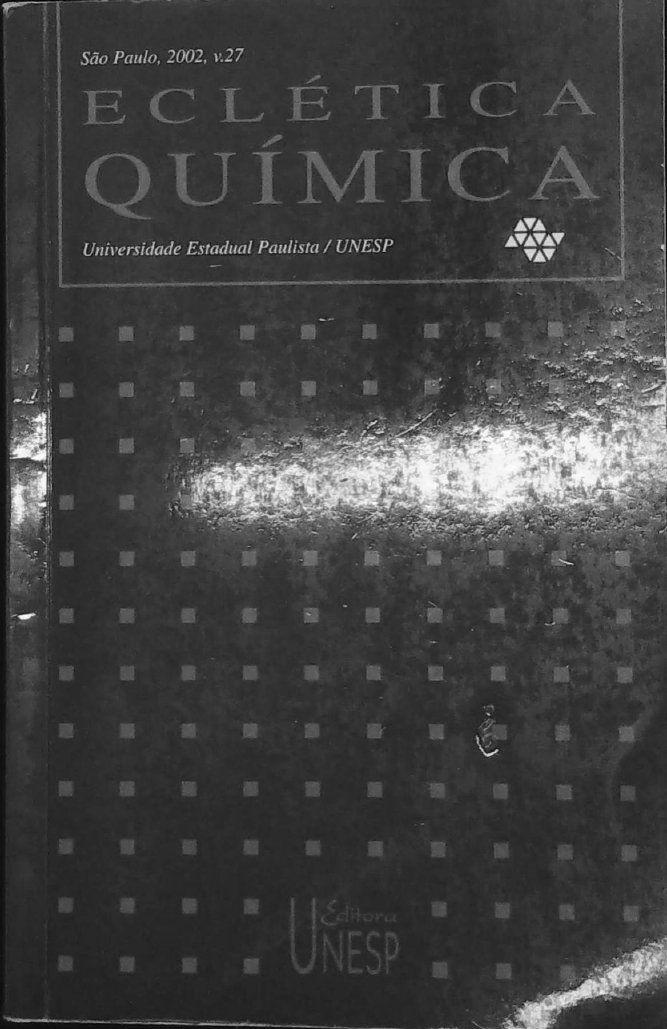Abstract
Pelo uso de técnicas mais baratas, como a do SDDC, é possível determinar níveis traços de arsênio em cabelo; entretanto esta técnica apresenta alguns inconvenientes como baixa estabilidade e o odor desagradável da piridina. A piridina foi substituída por trietanolamina/CHCl3 e as características analíticas do complexo foram estudadas.O complexo foi estável por 270 minutos, a faixa de aplicação da lei de Beer foi de 0,0 a 25,0 mg As, a repetibilidade foi de 0,028 mg As, o limite de detecção foi de 18,6 mg de As/L e a sensibilidade (e)? de 1,12 104 L.mol-1.cm-1. O método foi aplicado à amostras de cabelo. A lavagem das amostras foi feita com extran e água desionizada e seca em estufa (40-60ºC). 0,1000 g de amostra foi submetida à 11 métodos de digestão. O melhor método foi o que usou uma solução 1:1 de HNO3 e H2SO4 concentrados em temperatura de 100-110ºC com evaporação até fumos de SO3. O tempo de abertura é um inconveniente neste tipo de digestão.
References
AMERICAN PUBLIC HEALTH ASSOCIATION, American Water Works Association; Water Pollution Control Federation. Standard methods for the analysis of water and wastewater. 13th.ed. Washington, 1971. p.62-65. [ Links ]
ARBAB-ZAVAR, M.H.; HASHEMIi, M. Evaluation of electrochemical hydride generation for spectrophotometric determination of As(III) by silver diethyldithiocarbamate. Talanta, v.52., p.1007-1014, 2000. [ Links ]
BASADRE-PAMPÍN, M.; ALVAREZ-DEVESA, A.; BERMEJO-MARTÍNEZ, F.; BOLLAÍN- RODRIGUES, M. Spectrophotometric determination of arsenic with diethyldithiocarbamic acid silver salt and borohydride as reducing agent. Microchem. J., v. 23, p.360-365, 1978. [ Links ]
BENCKO, V.; DOBISOVA, A.; MACAJ, M. Arsenic in the hair of a non occupationally exposed population. Atmos. Environ., v.5, p.275-279, 1971. [ Links ]
CHATTERJEE, A.; DAS, D.; MANDAL, B.K.; CHOWDHURY, T.R.; SAMANTA, G. CHAKRABORTI, D. Arsenic in ground-water in 6 districts of West-Bengal, India - The biggest arsenic calamity in the world .1. arsenic species in drinking-water and urine of the affected people. Analyst, v.120, p.643-650, 1995. [ Links ]
CORRIDAN, J.P. Head hair samples as indicators of environmental pollution. Environ. Res., v.8, p.12-16, 1974. [ Links ]
DAS, D.; CHATTERJEE A.; MANDAL, B.K.; SAMANTA, G.; CHAKRABORTI D.; CHANDA B. Arsenic in ground-water in 6 districts of West-Bengal, India - The biggest arsenic calamity in the world .2. arsenic concentration in drinking-water, hair, nails, urine, skin-scale and liver-tissue (biopsy) of the affected people. Analyst, v.120, p.917-924, 1995. [ Links ]
FERRECCIO, C.; PSYCH, C.G.; STAT, V.M.; GREDIS, G.M.; SANCHA, A.M. Lung cancer and arsenic exposure in drinking water: a case-control study in northern Chile. Cad. Saúde Pública, v.14, sup.3, p.193-198, 1998. [ Links ]
FISH, R.H.; BRINCKMAN, F.E.; JEWETT, K.L. Fingerprinting inorganic arsenic and organoarsenic compounds in situ oil shale retort and process waters using a liquid chromatographcoupled with an atomic absorption spectrometer as a detector. Environ. Sci. Technol., v.16, p.174-179, 1982. [ Links ]
FOWLER, E.W. The determination of arsenic in germanium dioxide. Analyst, v.88, p.380-386, 1963. [ Links ]
GAILLARD, Y.; PEPIN, G. Testing hair for pharmaceuticals. J. Chromatogr. B, v.733, p.231–246, 1999. [ Links ]
GRANT, C.; DOBBS, A.J. The growth and metal content of plants growth in soil contaminatedby copper, chrome and arsenic wood preservative. Environ. Pollut., v.14, p.213-226, 1977. [ Links ]
GUPTA, P.K.; GUPTA, P.K. Microdetermination of Arsenic in water, spectrophotometrically by arsine silver diethyldithiocarbamate-morpholine-chloroform system. Microchem. J., v.33, p.243-251, 1986. [ Links ]
HOWARD, A.G.; ARBAB-ZAVAR, M.H. Sequential spectrophotometric determination of inorganic Arsenic (III)and Arsenic (V) species. Analyst, v.105, p.338-343, 1980. [ Links ]
HUNTER,D. The diseases of occupations. London: Hodder and Stoughton, 1975. p.335-357. [ Links ]
KNECHTEL, J.R.; FRASER, J.L. Preparation of a stable borohydride solution for use in atomic absorption studies. Analyst, v.103, p.104-105, 1978. [ Links ]
LIN, T.H.; HUANG Y.L.; WANG M.Y. Arsenic species in drinking water, hair, fingernails, and urine of patients with blackfoot disease. J. Toxico. Environ. Health Part A, v.53, p.85-93, 1998. [ Links ]
LYTTLE, D.A.; JENSEN, E.H.; STILUCK, W.A. A simple volumetric assay for sodium borohydride. Anal. Chem., v.24, p.1843-1844, 1952. [ Links ]
MARTÍ, F.B.; CONDE, F.L.; JIMENO, S.A.; MÉNDEZ, J.H. Quimica analitica cualitativa. Madri: Paraninfo, 1985. 1050 p. [ Links ]
MERRY, R.H.; ZARCINAS, B.A. Spectrophotometric determination of arsenic and antimony by the silverdiethyldithiocarbamate method. Analyst, v.105, p.558-563, 1980. [ Links ]
RAHMAN, L.; CORNS, W.T.; BRYCE, D.W.; STOCKWELL, P.B. Determination of mercury, selenium, bismuth, arsenic and antimony in human hair by microwave digestion atomic fluorescence spectrometry. Talanta, v.52, p.833–843, 2000. [ Links ]
SANDHU, S.S. Direct spectrophotometric method for the determination of hydrochloric acid releasable arsenic in sediments and soils. Analyst, v.106, p.311-315, 1981. [ Links ]
SARQUIS, M. Arsenic and old myths. J. Chem. Educ., v.56, p.815-818, 1979. [ Links ]
SPIELHOLTZ, G.I.; TORALBALLA, G.C.; STEINBERG, R.J. Determination of arsenic in coal and in insecticides by atomic absorption spectroscopy. Mikrochim. Acta, p.918-923, 1971. [ Links ]
TERZIC, L.J.; SLAVIC, M.; TERZIC, V. A spectrophotometric method for determination of micro-quantities of arsenic in different biological-materials - silver diethyldithiocarbamate in pyridine as the reagent for color development. Acta Vet. Beograd, v.31, p.79-86, 1981. [ Links ]
VASAK, V.; SEDIVEC, V. Chem. Listy, v.46, p.341-344, 1952. In: Chem. Abstr., v.47, p.67e, 1953. [ Links ]
WORLD HEALTH ORGANIZATION. Environmental health criteria: arsenic. Geneva:WHO, 1981. [ Links ]

This work is licensed under a Creative Commons Attribution 4.0 International License.
Copyright (c) 2018 Eclética Química Journal








